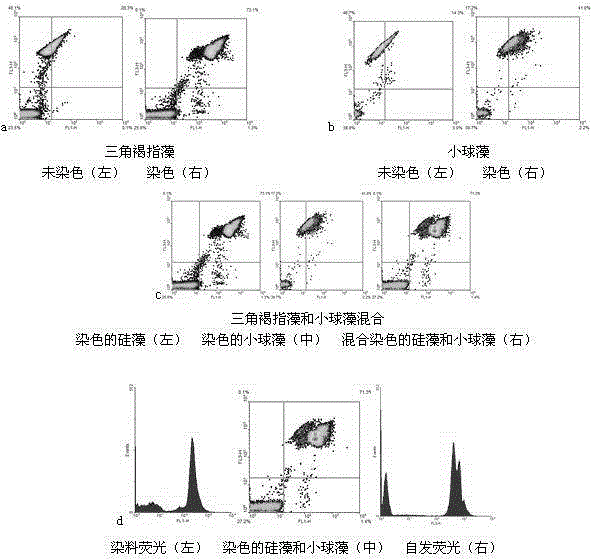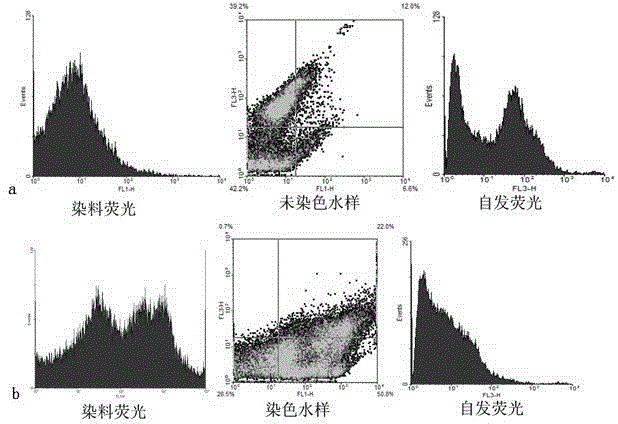Method of screening high grease algae from natural water body
A natural water body, high-fat technology, applied in the direction of microorganism-based methods, single-cell algae, biochemical equipment and methods, etc., can solve problems such as lack, and achieve the effect of simple screening process
- Summary
- Abstract
- Description
- Claims
- Application Information
AI Technical Summary
Problems solved by technology
Method used
Image
Examples
Embodiment 1
[0027] For two commonly used lipid-specific fluorescent dyes, different concentrations of dyes were selected and combined with a double-focus microscope to detect the optimal dyeing concentration
[0028] 1. Preparation of materials and reagents:
[0029] 1. Algae species: Chlorella is a microalgae with relatively high oil content. The chlorella in the logarithmic phase cultivated in the laboratory is selected for dyeing to find the best dyeing concentration.
[0030] 2. Dye solution preparation:
[0031] BODIPY505 / 515: Dissolve BODIPY505 / 515 dye with organic solvent dimethyl sulfoxide (DMSO), and make 5mM mother solution, store at -20°C.
[0032] Nile Red: Dissolve Nile Red dye in acetone, prepare a 25 μg / mL stock solution, and store at room temperature in the dark.
[0033] 3. Staining: use different concentrations of BODIPY505 / 515 and Nile Red dyes to stain Chlorella for 15 minutes at room temperature and dark. The dye concentrations are BODIPY 505 / 515: 2 μl / 5ml,...
Embodiment 2
[0035] Flow cytometry combined with fluorescent dyes to detect intracellular lipids in single microalgae
[0036] Algae selected for log phase culture: Phaeodactylum tricornutum Phaeodactylum and chlorella.
[0037] BODIPY505 / 515 dye at a concentration of 20 μl / ml was used to stain a single algae species and a mixture of the two algae at room temperature in the dark for 15 minutes, and the specific fluorescence intensity of the algae before and after staining was measured by flow cytometry (excitation length 488nm, emission wavelength 530nm). Draw 1ml of sample into a dedicated flow analysis test tube, set the filter: forward scattered light, side scattered light, red fluorescence and fluorescent signal. Then put the sample into the sampling system, and adjust the sampling speed at 0.1-1ml / h. 488nm laser excitation produces side scattered light, and the dye also emits fluorescent signals after passing through the laser beam. The scattered light signals and fluorescent s...
Embodiment 3
[0040] Obtained by the groping test of embodiment 1 and embodiment 2: a kind of method for screening high-fat algae from natural water body should comprise the steps:
[0041] S1. Collect water samples containing algae, filter to remove large organisms and impurities;
[0042] S2. Stain the water sample containing algae with a fluorescent dye with a concentration of 20-40 μl / ml (the fluorescent dye is BODIPY505 / 515 or Nile Red) at room temperature in the dark for 15 minutes, and use a flow cytometer with a sorting function to measure before and after staining. Algae fluorescence intensity and signal changes;
[0043] S3. Use a flow cytometer with a sorting function to screen out some water samples with strong intermediate specificity signals to obtain water samples of high-fat algae groups;
[0044] S4. Separating and culturing the water samples of high-fat algae groups to obtain pure microalgae species with high-fat content.
PUM
 Login to View More
Login to View More Abstract
Description
Claims
Application Information
 Login to View More
Login to View More - R&D
- Intellectual Property
- Life Sciences
- Materials
- Tech Scout
- Unparalleled Data Quality
- Higher Quality Content
- 60% Fewer Hallucinations
Browse by: Latest US Patents, China's latest patents, Technical Efficacy Thesaurus, Application Domain, Technology Topic, Popular Technical Reports.
© 2025 PatSnap. All rights reserved.Legal|Privacy policy|Modern Slavery Act Transparency Statement|Sitemap|About US| Contact US: help@patsnap.com



